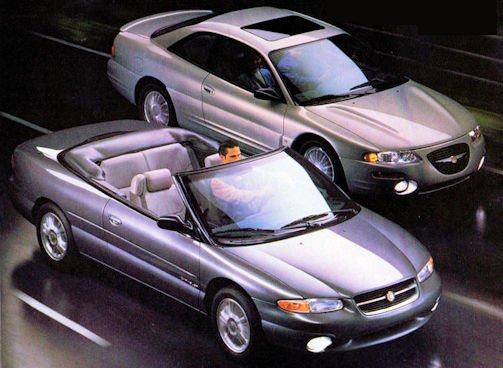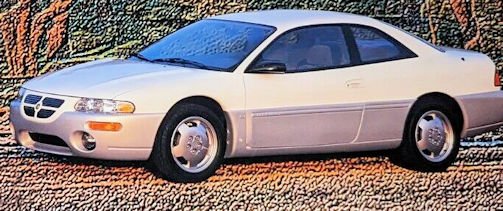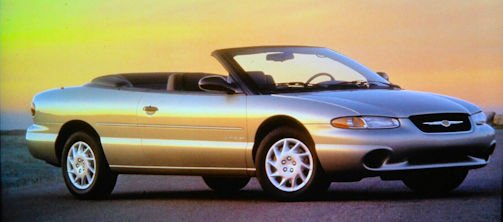Chrysler Sebring First Generation
 |
|
|
Production period: |
1995 to 2000 |
|
Class: |
Sports Car |
|
Body versions : |
Coupe Cabriolet |
|
Engines: |
Gasoline : 2.0-2.5 liters (104-121 kW) |
|
Length: |
4760 mm |
|
Width: |
1758 mm |
|
Height: |
1295 mm |
|
Wheelbase : |
2634 mm |
|
Curb weight : |
1276-1451 kg |
The Sebring coupe internal type designation: FJ was based on the technology of the Mitsubishi Galant and was a product of Diamond Star Motors , a joint venture between Chrysler and Mitsubishi . His technically identical sister model was the Dodge Avenger , technical relationship also exists with the Mitsubishi Eclipse .
In the spring of 1995 Chrysler brought the new Sebring as a coupe in the so-called cab-forward design with far forward passenger cabin and short front end on the market; From the Dodge Avenger, he differed mainly by the more conventional design of the front end with lying between the headlights grille, a square-shaped window line and C-pillar and a separate rear. Available the Sebring was basic model LX with 2.0 liter in-line four-cylinder engine with two overhead camshafts (maximum power: 104 kW), coupled with five-speed gearbox, and equipped as extensive Sebring LXi with 2.5 l V6 engine (maximum power: 116 kW) with four-speed automatic transmission. In 1996, the maximum power of the V6 engine was increased to 121 kW (165 hp).

In late 1997, the car was given a facelift, as evidenced by the larger radiator grille on which now sat the winged Chrysler emblem. Otherwise, the changes were limited to small details during the life of the Sebring.
By the end of production in the fall of 2000, the Sebring Coupé produced about 160,000 units.
Sebring Cabriolet (JX, 1996-2000)

The Sebring Cabriolet of the first generation (internal type designation: JX), which was sold in Europe as Stratus Cabriolet, was presented in 1995 or earlier and came in April 1996 on the market When this convertible was launched under the blazing sun of Palm Springs, California, Chrysler was determined to boast its qualities as a four-season car. With its front-wheel drive, waterproof top, heated glass rear window, and four seats, the Sebring appeared capable enough to drive in all weathers, no matter how harsh the elements. It was not based on the platform of the Sebring coupe. Although it was called "Sebring," this convertible's underpinnings had more in common with the Chrysler Cirrus than the Sebring coupe. This debuted for 1996, and offered fairly good accommodations that included front seat belts that retracted into the seatback. The rear window was glass rather than plastic. Safety equipment: Driver and passenger air bags standard. ABS optional.
The longer platform (269.2 cm wheelbase instead of 263.4 cm) of the Chrysler Cirrus and had an independent - with 490 cm about 15 cm long - body. Offered were the equipment JX and JXi, the engine of which corresponded to the LX and LXi models of the coupe, however, performed in the JX a 2.0 l to 2.4 l version of the Chrysler four-cylinder engine producing 150 horsepower .
In 1998, the equipment variant Limited came with V6 engine, four-speed automatic transmission, ABS, chrome-plated alloy wheels, traction control and leather interior in the program.
From the first Sebring Cabriolet Chrysler manufactured by the end of 2000 about 230,000 copies.
Technical
-
Technical details specifications
Sebring Cabriolet (JX, 1996-2000)
Type: 4-seater convertible / front-wheel drive
Wheelbase: 269 cm
Length: 490 cm
Width: 176 cm
Height:139 cm
Weight: 1506 kg
Trunk: 320 liters
Fuel Tank: 60 liters
Airbags: Driver and passenger
Traction Control: Yes (option)
Front/Rear Suspension: Independent
Front/Rear Brakes: ABS disc
Steering: Power-assisted rack-and-pinion
Turning Circle: 11 meters
Front/Rear Tires: P205/65R15
Basic Warranty: 3 years / 60,000 km© Motor car History
-Note: Advanced Maintenance and Repair Manuals available for registered users-
